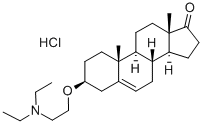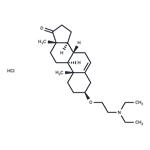Description
U-18666A (3039-71-2) is an oxidosqualene reductase inhibitor.1 Inhibits the egress of cholesterol from late endosomes and lysosomes.2 U-18666A is also used to study Niemann-Pick disease and for assessing the importance of molecular trafficking through the lysosomal pathway in other conditions.3
Uses
U 18666A is a cell-permeable amphiphilic amino-steroid.
Definition
ChEBI: 3beta-(2-diethylaminoethoxy)androst-5-en-17-one hydrochloride is a hydrochloride obtained by reaction of 3beta-(2-diethylaminoethoxy)androst-5-en-17-one with one equivalent of hydrochloric acid. It is a cholesterol synthesis and transport inhibitor. It has a role as an EC 1.3.1.72 (Delta(24)-sterol reductase) inhibitor, a nicotinic antagonist, a sterol biosynthesis inhibitor, an antiviral agent and a Hedgehog signaling pathway inhibitor. It contains a 3beta-(2-diethylaminoethoxy)androst-5-en-17-one(1+).
General Description
A cell-permeable, amphiphilic amino-steroid that alters intracelluar membrane protein trafficking by impairing intracellular biosynthesis and transport of LDL-derived cholesterol. Reported to exert its effects via the inhibition of 2,3-oxidosqualene-lanosterol cyclase activity. Also reported to inhibit the activity of Δ
8-sterol isomerase.
Biological Activity
Inhibitor of cholesterol synthesis and cellular transport, and weak inhibitor of hedgehog (Hh) signaling. Reduces serum sterol levels in rats in vivo .
Biochem/physiol Actions
Cell permeable: yes
References
1) Sexton et al. (1983) Effects of 3.beta.-[2-(diethylamino)ethoxy]androst-5-en-17-one on the synthesis of cholesterol and ubiquinone in rat intestinal epithelial cell cultures; Biochemistry 22 5687
2) Liscum and Faust (1989) The intracellular transport of low density lipoprotein-derived cholesterol is inhibited in Chinese hamster ovary cells cultured with 3-?-[2-(diethylamino)ethoxy]androst-5-en-17-one; J. Biol. Chem. 264 11796
3) Cenedella, (2009) Cholesterol synthesis inhibitor U18666A and the role of sterol metabolism and trafficking in numerous pathophysiological processes; Lipids 44 477

